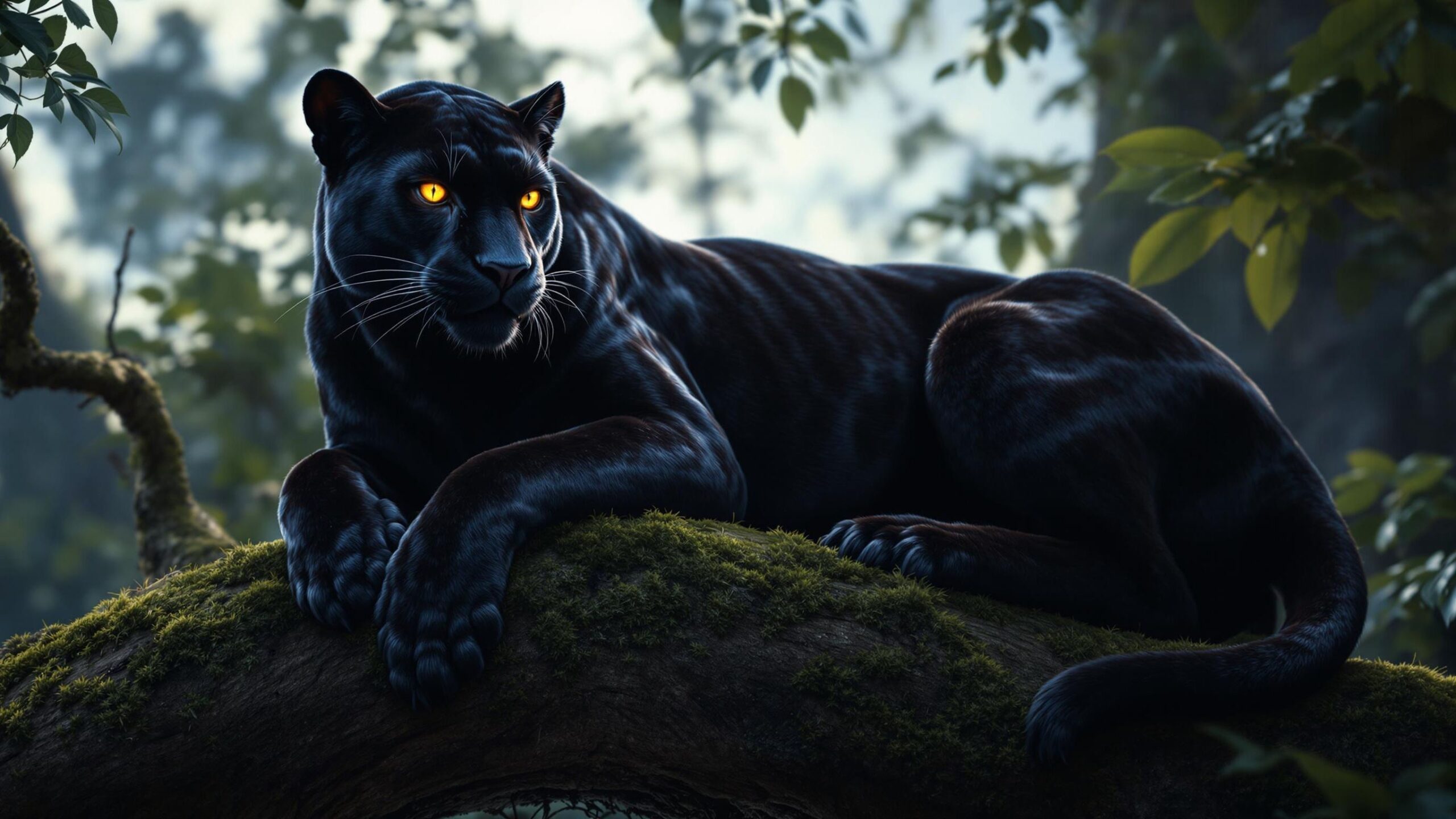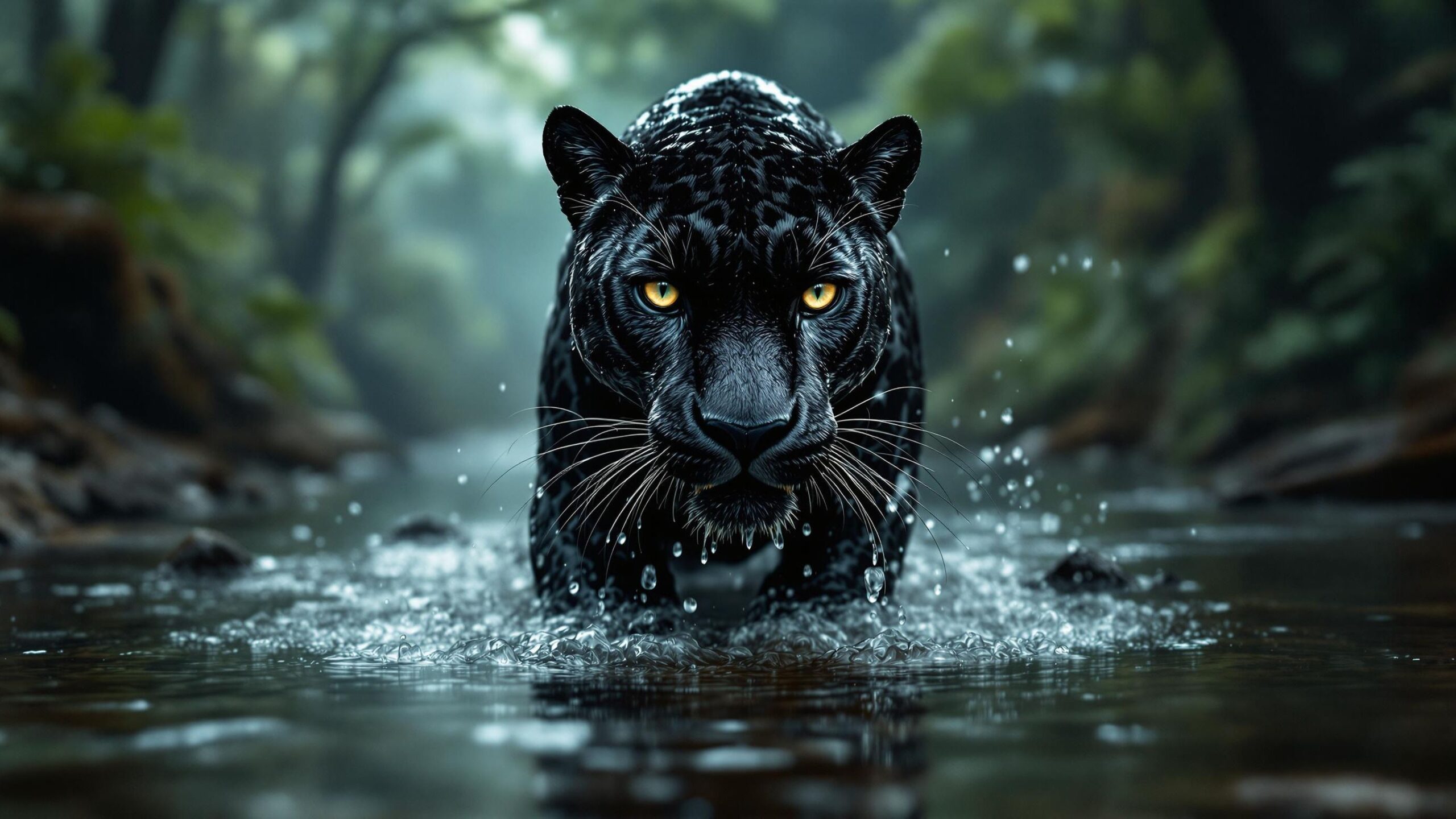Black Panther: Nature’s Elusive Shadow
In the misty forests of Southeast Asia, the dense jungles of Africa, and the lush landscapes of South America, a shadowy figure moves silently through the undergrowth. With piercing eyes, graceful movements, and a coat as dark as midnight, this rare and mysterious creature has long captivated the human imagination. Known collectively as the Black Panther, these animals are not a distinct species, but rather melanistic (black-coated) variants of two species of big cats: the leopard (Panthera pardus) and the jaguar (Panthera onca). Despite their fame in folklore, popular culture, and even superhero comics, real-life black panthers remain elusive, powerful, and endlessly fascinating.
What Is a Black Panther?
The term “black panther” does not refer to a separate species but instead describes big cats with a genetic condition known as melanism. This condition causes an overproduction of the dark pigment melanin, giving the animals their characteristic black appearance. Black panthers can either be leopards (found in Africa and Asia) or jaguars (native to the Americas), depending on their geographic location.
Melanistic leopards are more commonly found in the dense forests of India, Sri Lanka, and parts of Southeast Asia, where their dark coloration provides excellent camouflage. Melanistic jaguars are rarer, but they have been spotted in the rainforests of the Amazon and parts of Central America. Interestingly, although their fur appears black at a glance, if you look closely or under strong light, you can often see the faint rosette patterns typical of their species.bThe term “panther” itself has long been used ambiguously, sometimes referring to leopards, jaguars, or even cougars (also known as mountain lions or pumas) in North America. But in modern scientific and conservation circles, “black panther” is typically used only for melanistic leopards and jaguars
Origins of the Shadow Coat
Melanism in big cats is the result of a genetic mutation that increases the production of melanin in the skin and fur. In leopards, this trait is caused by a recessive allele, meaning both parents must carry the gene for melanistic offspring to appear. In jaguars, however, melanism is caused by a dominant allele, making it more likely to occur in populations where the gene exists.
What makes this trait particularly interesting is that it appears to have a natural advantage in some environments. In thick, shadowy rainforests where light is sparse, a black coat helps these cats stay hidden while stalking prey or avoiding detection. This evolutionary benefit may explain why black panthers are more commonly found in heavily forested regions than in open savannas or grasslands.
Physical Characteristics
At first glance, a black panther looks like a solid black cat with a powerful, muscular build. However, their appearance still reflects their underlying species. Black leopards are typically more slender with a long tail and are agile climbers, while black jaguars are more robust and have a stockier, more powerful frame with a broader skull and shorter limbs.
Even though their coats appear uniformly dark, these animals retain the distinctive rosette patterns of their species—markings that become visible under certain lighting conditions. Their eyes, often golden or green, stand out strikingly against their dark fur, adding to their almost mythical presence. Both types of black panthers are equipped with exceptional senses. Their acute night vision, silent movement, and impressive strength make them master hunters. Whether stalking prey through dense jungle undergrowth or waiting patiently in trees, they excel at ambush predation.

Habitat and Range
Black panthers are highly adaptable and are found in a range of forested habitats, though their distribution closely follows that of their non-melanistic counterparts. In Asia and Africa, melanistic leopards are usually found in tropical rainforests, mountainous regions, and forested savannas. India, in particular, is known for its relatively high population of black leopards, with notable sightings in Karnataka, Kerala, and Maharashtra. Sri Lanka and parts of Malaysia have also documented regular appearances.
In the Americas, melanistic jaguars are primarily found in the Amazon Basin, especially in Brazil and surrounding countries. These areas provide the dense cover and diverse prey base ideal for jaguars of any coloration, but especially for those with dark coats. These animals are solitary by nature and typically maintain large territories, marking them with scent and scratch marks to warn off intruders. They are rarely seen in the wild, both because of their stealthy nature and because they tend to live in hard-to-reach areas.
Behavior and Hunting Tactics
The black panther’s hunting style is a masterclass in stealth and strategy. These predators are primarily nocturnal, taking full advantage of their dark coloring to move undetected through their environment. Unlike cheetahs or lions, which rely on speed or group coordination, black panthers depend on patience, concealment, and sudden explosive power.
They are ambush predators, often stalking prey from a distance before delivering a deadly pounce. Leopards, including black ones, are known for their climbing prowess and often haul their kills into trees to avoid scavengers. Jaguars, on the other hand, tend to favor water-rich environments and are known to prey on fish, caimans, and even large mammals such as capybaras and deer. A jaguar’s bite is one of the most powerful among big cats, strong enough to crush the skull or shell of its prey. Despite their solitary lifestyle, black panthers are attentive mothers. Female leopards or jaguars raise their cubs alone, teaching them essential hunting and survival skills. Cubs stay with their mother for up to two years before venturing off to establish their own territories.
Cultural Significance
Throughout history, the black panther has been a powerful symbol in many cultures. Its mysterious appearance and elusive behavior have earned it a place in mythologies, folktales, and spiritual traditions across the world. In ancient Southeast Asian and African traditions, black panthers were often regarded as guardians of the forest and symbols of strength and secrecy. Some cultures saw them as omens or spiritual guides, believed to possess otherworldly powers or knowledge of the unseen.
In more modern times, the term “Black Panther” became a cultural icon in the 20th century, particularly in the United States, where it was adopted by the Black Panther Party, a revolutionary political organization advocating for civil rights and social justice. The symbol of the black panther was chosen to represent dignity, resilience, and empowerment. More recently, Marvel Studios’ Black Panther franchise has elevated the animal’s status to global prominence, linking it with Afro-futurism, heroism, and cultural pride. Though fictional, the character of T’Challa and the technologically advanced nation of Wakanda have inspired real-world conversations around representation and cultural heritage.
Conservation Status
While the black panther itself is not a species listed as endangered, its parent species—leopards and jaguars—face varying degrees of conservation concern depending on the region. Leopards are currently listed as Vulnerable on the IUCN Red List, though some subspecies, such as the Amur leopard, are critically endangered. Habitat loss, human-wildlife conflict, and poaching are among the biggest threats. In places like India, black leopards are increasingly found in human-dominated landscapes, which leads to both greater visibility and greater risk.
Jaguars are classified as Near Threatened, with populations declining primarily due to deforestation, illegal hunting, and fragmentation of their natural range. Black jaguars, being rarer, face all the same threats, but their scarcity makes them even more vulnerable to genetic bottlenecks in small, isolated populations. Fortunately, several national parks, wildlife corridors, and conservation programs are working to protect leopard and jaguar habitats. From the Amazon rainforest to the Western Ghats of India, protected reserves play a vital role in allowing these magnificent animals—black-coated or otherwise—to survive.
Sightings and Rarity
One of the reasons black panthers have developed such a legendary status is their rarity and the difficulty of spotting them in the wild. Even seasoned wildlife photographers may go their entire careers without encountering one. When they are spotted, the images often go viral due to their sheer mystique.
In recent years, advances in camera trap technology have given researchers better tools to monitor these elusive cats. In India, some regions have become famous for their recurring black leopard sightings, allowing for more systematic observation of their behavior and movements. zStill, no matter how often they are photographed, black panthers remain wrapped in a shroud of mystery. Their secretive nature, nighttime habits, and shadowy coats allow them to slip past human eyes with ease, reinforcing their almost mythical reputation.
Black Panther Myths and Misconceptions
There are several misconceptions surrounding black panthers. Perhaps the most common is the belief that black panthers are a distinct species or that they can be found in North America. While cougars (also called panthers in places like Florida) live in parts of North America, they do not exhibit melanism, and no verified sightings of true black cougars exist.
Another myth is that black panthers are inherently more aggressive than their spotted counterparts. There is no scientific evidence to support this claim. Like all big cats, behavior varies by individual, environment, and circumstance, not by coat color. Also, while black panthers are sometimes believed to be more successful hunters due to their camouflage, studies suggest the advantage is context-dependent. In dense forests, the dark coat may offer a stealth advantage, but in open landscapes, it could actually be a liability.

The Allure of the Unknown
What continues to captivate us about the black panther is not just its rarity or beauty, but the feeling that it belongs to a realm slightly beyond reach. It embodies everything we find awe-inspiring in nature: power cloaked in silence, mystery that resists full understanding, and a deep, primal connection to the wild.
For many, the black panther is a living reminder that the natural world still holds secrets, even in an age of satellites and smartphones. Its presence tells us that there are corners of the earth where the wild still reigns, where shadows move on silent paws, and where magic is real—not in the realm of fantasy, but in the forest, where few dare to look.
Conclusion
The black panther, whether leopard or jaguar, is an animal of stunning grace, strength, and intrigue. Its sleek black coat is more than a fashion statement—it’s a product of evolution, finely tuned to the environments it inhabits. It is a symbol of mystery, a star of folklore and modern media, and a critical part of the ecosystems it calls home.
Though conservation efforts continue to face challenges, awareness of these remarkable creatures is growing. As long as there are forests for them to roam and eyes that seek them in the dark, the black panther will remain one of the most iconic, beautiful, and mysterious animals in the natural world.

